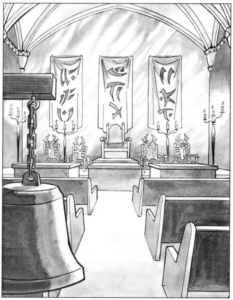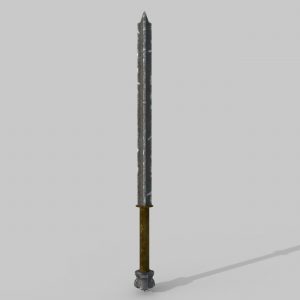DM Note: THIS is the recommended religion for Player Character Clerics, (although any subset below is fine.) All parties will be starting in the southern half of Solista. Within the 40+ regions, countries and nations of Solista, only one, Tarpia, has any significant Balan presence. Finding Balan clerics, temples or such, anywhere else in Solista will be impossible and hostility levels towards Balan Clerics will be high.
Kostris is, or was and will be, the earthly embodiment of the Creator. Kostris came to earth to elevate men above animals by giving them Souls and teaching them how to be human.
Kostris gave man his soul, known as the “Gift of Kostris” and taught him the skills needed to be human. Right and wrong, good vs. evil and things like, agriculture, fire, pottery, writing, etc. After giving man these gifts Kostris left him on his own to develop as best he could and to strive for perfection. Many, many thousands of years later Kostris returned to earth. Man had strayed far from the path he had been set upon and Kostris sought to start him afresh. But evil had taken a deep root and its forces betrayed Kostris and murdered his earthly manifestation. Before he died Kostris promised to return once more, just before the end, and collect all those, living and dead, who were true to his teachings and take them to paradise.
Today the followers of Kostris are known as the ‘Children of Kostris’ and they seek to live by the tenants taught by Him. Unfortunately there are volumes of Kostris teachings, quotes, parables, interpretations, comments, analysis, etc. Consequently dozens of sects now exist, each claiming the “True Path’ or ‘Revealed Teachings’ etc, etc, etc…
All together the ‘Children’ represent about 60% of the population (total) of Solista.
Of the various groups, three are the most influential.
Orthodox
The largest and oldest of the Kostris faiths. It commands the allegiance of at least 60% of the Solistan, Kostrin, population. They are a powerful, multinational force owning vast holdings and fielding large bodies of troops when needed. The center of the Orthodox church is in Gennos and its leader is the Patriarch. The Orthodox regard all the other Kostris sects, especially the Reform and Followers of Darrian, as Heretics.
Orthodox clerics wear a dark blue robe piped with white. The Acolyte (1st level Cleric) goes forth with his robes, (A daily set, ceremonial and a talbard. A Bar Mace, a copy of the Common Missal (See Clerics and Equipment) and a Bronze holy symbol.

Kostrin Orthodox Temple
Reform
The Reform church believes that the Orthodox have lost track of the Truth of Kostris and become obsessed with earthly goals of wealth and power. They are the second most numerous sect, commanding about thirty percent of the Faithful. Less structured and hierarchical than the Orthodox, but still a major political power. There is no central authority, rather there are national leaders, Bishops and Arch Bishops, who ally with each other as needed. The Reform regard the Orthodox as misguided heretics and pity the Followers of Darrian as deluded heretics.
Reform clerics wear a solid dark blue robe. The Acolyte (1st level Cleric) goes forth with his robes, (A daily set, a ceremonial set and a talbard.) A Bar Mace, a copy of the Common Missal (See Clerics and Equipment) and a Bronze holy symbol.
Followers of Darrian
Darrian was an Orthodox Priest who claimed to speak with Kostris on an almost daily basis. His ability to perform astonishing miracles seemed to lend credence to his claims. Though he has since ascended (died) he has about 8% of the Kostrin population as devoted and vocal followers. Darrian claimed that both Orthodox and Reformed churches have strayed and that only he could guide them down the right road. He said that the end was near, Kostris would return soon and those who followed the false faiths were doomed. There are no major holdings or centers of power, rather charismatic and inspired local leaders. They hate both the Orthodox and Reform churches.
Darrian clerics wear plain brown robes and eschew ceremonial robes or talbards. The Acolyte (1st level Cleric) goes forth with his robe, a Bar Mace, a copy of the Common Missal (See Clerics and Equipment) and an Iron holy symbol.
Kostrin Clerics (All denominations)
There is a long standing restriction in the Kostrin Churches against the use of bladed, edged and pointed weapons. Teachings say that this prohibition is the result of a command by Kostris to ‘Not Shed the Blood of Thy Neighbor…’ (He did NOT say don’t kill!) Traditional battle maces often have flanges around the heads, so early Church Leaders adopted a version of an old and simple Dwarven weapon, the Bar Mace. (See weapon description for details.)
A Kostrin Bar Mace will have the shaft engraved on all sides with holy symbols, various scriptures and prayers. Such a mace is given to every Kostrin Cleric upon ordination.
Silvered versions are often awarded to clerics that prove particularly courageous against the Darkness.

Kostahnas (Light Sticks)
These are hardwood sticks about the size of an ordinary candle or taper (12” long and as thick as a finger.) They are carved ans engraved with prayers, symbols and teachings of the Orthodox Kostrin Church. Each stick is Consecrated and blessed and has a Continual Light placed on them. They are gifted by Orthodox clerics to members of their flock during the Winter Solstice (Shortest Day) services.
The sticks are generally carved at Orthodox Monasteries and are parceled out, illuminated, to local temples. (The manufacturing monastery will be marked somewhere on the stick.) Typically the light of a Kostahnas will last anywhere from 16 to 30 months before fading and going out. The demand always exceeds the supply, with a small temple receiving only half a dozen each year. (Alms and gifts of food and clothing are distributed to worshipers during the service, everyone gets something though only a few get Kostahnas.
Only the Orthodox church makes and distributes Kostahnas. The Reform church limits itself to Alms, food and clothing for their Solstice Services. The Followers of Darrian have no such practice.
Though no follower would willingly sell their Kostahna, the sticks have a market value of 175gp